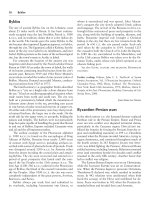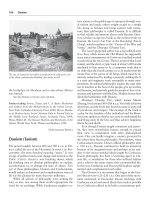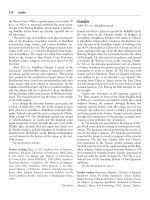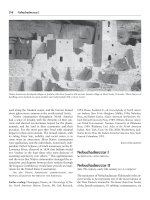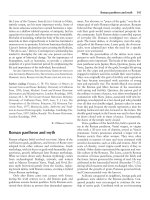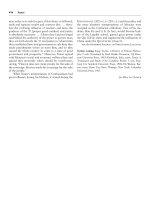Encyclopedia of world history (facts on file library of world history) 7 volume set ( PDFDrive ) 193
Bạn đang xem bản rút gọn của tài liệu. Xem và tải ngay bản đầy đủ của tài liệu tại đây (63.16 KB, 1 trang )
154
Ganjin
the human form. While exquisite pieces of art from 50
b.c.e. to 400 c.e. survived, probably the most recognizable is the Fasting Buddha, which depicts a meditating Buddha whose bones are literally exposed due to
his starvation.
The golden age of Gandhara took place during the
rule of the Kushans. Countless remains of Buddhist
monasteries, large statues, and various Buddhist stupas survived from this era. The Kushan monarch Kanishka (128–151 c.e.) ruled his kingdom from Peshawar in Gandhara. The empire stretched from southern
India to the border of Han China. From Peshawar,
Buddhist culture, religion, and art were spread to the
Far East.
After 241 c.e. Gandhara became a vassal of the
Sassanians. Until the fifth century it remained a center
of culture, artistic activity, and commerce. This period
was marked by the production of giant statues of the
Buddha that were carved into mountainsides and other
large statues that were placed in monasteries. By the
middle of the fifth century the Huns invaded Gandhara,
and the culture slid into a period of decay. Buddhism
fell into decline, while some practice of Hinduism resurfaced. The Sassanids drove out the Huns in the middle
of the sixth century.
Even though the Sassanid Empire came under the
control of Islam after 644, the Arabs seemed to have
little interest in Gandhara. Buddhism continued there
under Turkish rule until the area’s conquest by Hindushahi around 870. The Hindushahi capital was moved
to Udabhandapura in Gand, and the kingdom once
again prospered, at least through the early part of the
Middle Ages. Around 1021 the region was taken over
by Muslim leaders, and the kingdom of Gandhara was
absorbed into the Islamic world. British archaeologists
revived interest in the history of the region in the mid19th century.
See also Kushan Empire.
Further reading: Dani, A. H. Gandhara Art of Pakistan.
Peshawar, Pakistan: University of Peshawar, 1968; Dani,
A. H., and V. M. Mason, eds. History of Civilizations
of Central Asia. Paris: Unesco, 1992–2005; GeoffroySchneiter, Berenice. Gandhara: The Memory of Afghanistan. New York: Assouline, 2001; Hussain, J. An Illustrated History of Pakistan. Oxford: Oxford University
Press, 1983; Salmon, Richard. Ancient Buddhist Scrolls
from Gandhara. Seattle: University of Washington Press,
1999.
Tim Davis
Ganjin
(688–763 c.e.) Buddhist monk
Ganjin traveled to Japan to spread the Buddhist faith.
He was born in the Chinese county of Jiangyin in
Guangling (Yangzhou, Jiangsu). His name in Chinese
is Jianzhenis (Chien-chen); Ganjin is the Japanese version. He entered the Buddhist temple of Daming at the
age of 14. He studied at Chang’an (Ch’ang-an) for six
years, starting at the age of 20. He then returned to the
Daming Temple where he eventually became the abbot
of the temple. He also trained in medicine and opened
a hospital, the Beitian Court, at the Daming Temple.
In 732 c.e. the Japanese government sent an emissary
to China, including two priests searching for a precept
transmitter to come to Japan. In 742 they met with
Ganjin and his followers. None of Ganjin’s followers
was willing to go, so he decided to go himself. The
crossing from China to Japan across the East China
Sea was dangerous, and it took six tries before Ganjin
reached Japan in 753. During the fifth attempt, he lost
his eyesight.
Ganjin was welcomed at the Japanese capital in
754. That summer, in front of the Great Buddha Hall
at Todai-ji, a ceremony was held in which the retired
emperor Shomu, the empress dowager Komyo, the
reigning empress Koken, and 440 clergy received the
precepts. An order was issued to build a precept hall
and living quarters for Ganjin. Ganjin’s arrival in Japan
brought the transmission of the precept, in Japan, back
toward a more orthodox way of doing it.
In 756 Ganjin was appointed to the bureau of clergy, which controlled the issuing of certificates for ordination. The Japanese viewed protecting the nation as
part of the clergy’s mission. The Japanese government
expected the priests to work in support of the nation’s
prosperity. The fact that Ganjin, who was Chinese,
was appointed to the bureau speaks volumes about
his skill and the level of his understanding of the Buddhist religion. Ganjin resigned from the bureau in 758
and returned to training priests. Ganjin continued to
teach up until his death on June 22, 763. He is considered one of the founding fathers of Sino-Japanese
medicine.
See also Buddhism in China.
Further reading: Hanayama, Shinsho. A History of Japanese
Buddhism. Trans. by Kosho Yamamoto. Tokyo: Bukkyo
Dendo Kyokai, 1960; Kashiwahara, Yusen, and Koyu Sonoda. Shapers of Japanese Buddhism. Translated by Gaynor
Sekimori. Tokyo: Ksei Publishing, 1994; Tamura, Yoshiro.

